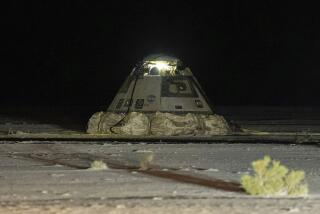Weary Pilots End 111-Hour Non-Stop Flight
- Share via
MOJAVE — The spindly airplane Voyager and its two weary pilots landed on a desert airfield at dawn Tuesday, after 111 hours of flight without stopping or refueling, apparently shattering several aviation records.
Several hundred relatives, friends and fans cheered the 6:36 a.m. landing and doused pilot Dick Rutan, 46, and co-pilot Jeana Yeager, 32, with Champagne.
“The flight went much better than anticipated . . . and I frankly didn’t think we’d even make it,” a fatigued Rutan said.
The $1-million experimental plane--really a flying fuel tank with two engines--began its flight from Vandenberg Air Force Base 120 miles northwest of Los Angeles at 2:52 p.m. on Thursday.
Its 11,857-mile flight was a prelude to a planned 12-day attempt in mid-September to fly 25,000 miles around the globe without refueling.
Closed-Loop Flight
Organizers of the flight reported an 11,600.9-mile, closed-loop flight to the National Aeronautic Assn. The 257 miles of the flight not reported to the association were outside the closed circuit loop over the Pacific Ocean between San Luis Obispo and San Francisco--those miles flown immediately after takeoff to get to the designated starting point over the ocean and the miles flown to land at Mojave.
If certified, the 11,600.9 miles will break the previous record of 11,337 miles set in 1962 by Air Force Capt. Bill Stevenson in a B-52H jet bomber.
The long hours in cramped quarters consisting of a cockpit and a tiny sleeping area clearly took their toll on Rutan and Yeager.
At a post-flight news conference, Yeager collapsed into the arms of a flight surgeon moments after commenting about the constant engine noise aboard the craft.
“We were having trouble with the noise . . . the fatiguing level of the noise, the vibrations--our heads (are) still kind of a roar right now,” she said before she collapsed.
Asked if she were ready for the ‘round-the-world flight, Yeager replied, “Can we wait till tomorrow?”
Dr. George Jutila, the flight surgeon, said Yeager suffered from simple fatigue caused by not drinking enough water and the long confinement in the tight space. She was revived quickly inside a hangar.
During the Voyager’s approach to Mojave Airport, 75 miles northeast of downtown Los Angeles, the crew of a chase plane told Rutan that the craft was too high for the landing. But he radioed back that he was not going to go around again because he and Yeager did not want to spend any more time in the plane.
Rutan said that despite the length of the flight, there was always something to do and little idle time.
‘Really Isn’t Time’
“There really isn’t time to sit back and have a casual conversation,” he said.
Rutan said he planned to have better sleeping pads and sound insulation installed in the rear of the plane, where the pilot who is not at the controls spends off hours. Voyager’s only seat is in the cockpit.
“After three days, I felt like I’d been in there all my life. It was like a cocoon,” said Rutan, who wore a purple lei. Yeager agreed. “It was kind of fatiguing being cramped up so long,” she said.
The two ate freeze-dried meals and used specially designed, sealable plastic bags to dispose of body wastes.
The Voyager crew is claiming three other world records.
Two of those records involve non-stop mileage flown by two classes of piston-engine aircraft, but such records are not considered nearly as important as the absolute distance record. The third record concerned unrefueled endurance.
Old Distance Record
In the previous closed-loop distance record, Stevenson’s bomber flew in one loop from March Air Force Base, near Riverside, around Alaska, Greenland, Bermuda and Florida before returning to California.
National Aeronautics Assn. officials, responsible for certification of records, flew alongside Voyager for much of its journey to validate the flight.
The plane averaged 103.5 m.p.h. and got 29 miles per gallon of fuel during the flight, said its designer, Burt Rutan, brother of the pilot.
The plane is made of lightweight material, has a 110-foot wingspan and carries 17 fuel tanks. It has two engines, one pushing and one pulling. Only one of the engines is used at a time during flight.
The venture, five years in the making, is being financed through a combination of corporate and private contributions, according to Voyager spokesman Peter Riva.
More to Read
Sign up for Essential California
The most important California stories and recommendations in your inbox every morning.
You may occasionally receive promotional content from the Los Angeles Times.










